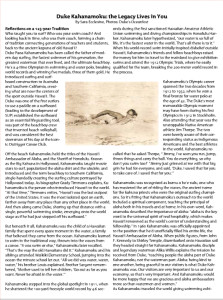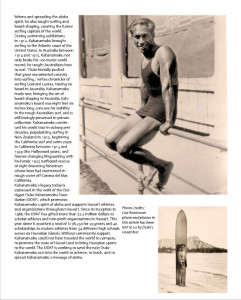Reflections on a 125-year Tradition
Who taught you to surf? Who was your swim coach? And looking back in time, who was their coach, forming a chain of tradition connecting generations of teachers and students, back to the ancient kapuna of old Hawai’i?
Duke Paoa Kahanamoku has been called the father of modern day surfing, the fastest swimmer of his generation, the greatest waterman that ever lived, and the ultimate beachboy. He’s a 4-time Olympian in swimming and water polo, breaking world records and winning five medals, three of them gold. He introduced surfing and surfboard construction to Australia and Southern California, creating what are now the centers of the sport outside Hawai’i. The Duke was one of the first surfers to use a paddle on a surfboard (leading to the development of SUP) established the surfboard as an essential lifeguarding tool, was part of the beachboy crew that invented beach volleyball, and was considered the one of the best steersmen of his day at the iconic Outrigger Canoe Club.
Off the beach Kahanamoku held the titles of the Hawai’i Ambassador of Aloha, and the Sheriff of Honolulu. Known as the Big Kahuna in Hollywood, Kahanamoku taught movie stars to surf, popularized the aloha shirt and the ukulele, and introduced and the term beachboy to Southern California, single-handedly creating the surfing culture portrayed by Hollywood today. As biographer Grady Timmons explains, Kahanamoku is the person who introduced Hawai’i to the world. “At that time,” Timmons writes, “Hawai’i was the last outpost of the United States. It was the most isolated spot on earth, farther away from any place than any other place in the world. And then along came Duke, shoring up that distance with a single, powerful swimming stroke, emerging onto the world stage as if he had just stepped off his surfboard.”
But beneath it all, Kahanamoku was the child of a Hawaiian family that spent every spare moment in the water, a family that believed they came from the ocean. Kahanamoku learned to swim in the traditional way, thrown into the waves from a canoe. “It was swim or else,” Kahanamoku later recalled. “That’s the way the old Hawaiians did it.” Kahanamoku and his siblings attended Waikiki Elementary School, jumping into the ocean the minute school let out. “All we did was water, water, water,” his brother Louis explained. Brother Sargent remembered, “Mother used to tell her children, ‘Go out as far as you want. Never be afraid in the water.’”
Kahanamoku stepped into the global spotlight in 1911, when he shattered the 100-yard freestyle world record by 4.6 seconds during the first sanctioned Hawaiian Amateur Athletic Union swimming and diving championships in Honolulu Harbor. Kahanamoku later hypothesized, “our water is so full of life, it’s the fastest water in the world. That’s all there is to it.” When his world-record swim initially inspired disbelief outside Hawai’i, Kahanamoku’s friends and fellow beachboys raised the money for him to travel to the mainland to give exhibition swims and attend the 1912 Olympic Trials, where he easily qualified for the team, breaking the 200-meter world record in the process.
Kahanamoku’s Olympic career spanned the two decades from 1912 to 1932, when he won a final bronze for water polo at the age of 42. The Duke’s most memorable Olympic moment may have come during his first Olympics in 1912 in Stockholm. Also attending that year was the unstoppable Native American athlete Jim Thorpe. The two were keenly aware of their corresponding status as indigenous Americans and the best athletes in the world. Kahanamoku recalled that he asked Thorpe, “’Jimmy, I’ve seen you run, jump, throw things and carry the ball. You do everything, so why don’t you swim too?’ Jimmy just grinned at me with that big grin he had for everyone, and said, ‘Duke, I saved that for you to take care of. I saved that for you.'”
Kahanamoku was recognized as kumu o he’e nalu, one who has mastered the art of riding the waves, the ancient name for the kahuna priests who were the original surfing champions. So it’s fitting that Kahanamoku’s outreach to the world included a spiritual component, teaching the principal of aloha both in his travels and at home. In his own word, Kahanamoku described the importance of aloha: “aloha is the key word to the universal spirit of real hospitality, which makes Hawai’i renowned as the world’s center of understanding and fellowship.” In 1960 Kahanamoku was officially appointed to the position that he’d unofficially filled his entire life, the Hawai’i Ambassador of Aloha. When public figures, from John F. Kennedy to Shirley Temple, disembarked onto Hawaiian soil they headed straight for Kahanamoku. Kahanamoku disciple and legendary waterman Alika Willis explains the mission he received from Duke, “teaching people the aloha part of Duke Kahanamoku, not the waterman part. Aloha: being kind to one another, being graceful to our visitors is what Duke Kahanamoku was. Our visitors are very important to us and our economy, so that’s very important. And Kahanamoku would be more happy that we are gracious and aloha ambassadors more so than watermen and women.”
As Kahanamoku traveled the world giving swimming exhibitions and spreading the aloha spirit, he also taught surfing and board-shaping, creating the future surfing capitals of the world. During swimming exhibitions in 1912, Kahanamoku brought surfing to the Atlantic coast of the United States. In Australia between 1914 and 1915, Kahanamoku not only broke his 100-meter world record, he taught Australians how to surf. “Duke literally pushed that great sea-oriented country into surfing,” writes chronicler of surfing Leonard Lueras. Having no board in Australia, Kahanamoku made one, bringing the art of board-shaping to Australia. Kahanamoku’s board was eight feet six inches long, concave for stability in the rough Australian surf, and is still lovingly preserved in private collection. Kahanamoku continued his world tour in subsequent decades, popularizing surfing in New Zealand in 1915, beginning the California surf and swim craze in California between 1913 and 1929 (the Hollywood years), and forever changing lifeguarding with his heroic 1925 surfboard-rescue of eight drowning fishermen whose boat had overturned in rough water off Corona del Mar, California.
Kahanamoku’s legacy today is expressed in the work of the Outrigger Duke Kahanamoku Foundation (ODKF), which promotes Kahanamoku’s spirit of aloha and supports Hawai’i athletes and organizations throughout Hawai’i. Since its inception in 1986, the ODKF has gifted more than $2.2 million dollars to scholar athletes and non-profit organizations in Hawai‘i. This year alone it awarded a total of $178,250 for 29 grants and 40 scholarships to student athletes from 34 different high schools across six Hawaiian Islands. Without community support, Kahanamoku could not have traveled the world to compete, to promote the state of Hawai’i and to bring Hawaiian sports to the world. The ODKF is working to send the next Duke Kahanamoku out into the world to achieve, to teach, and to spread Kahanamoku’s message of aloha.
This article originally appeared in the July-August issue of Hawaii Sport Magazine.

